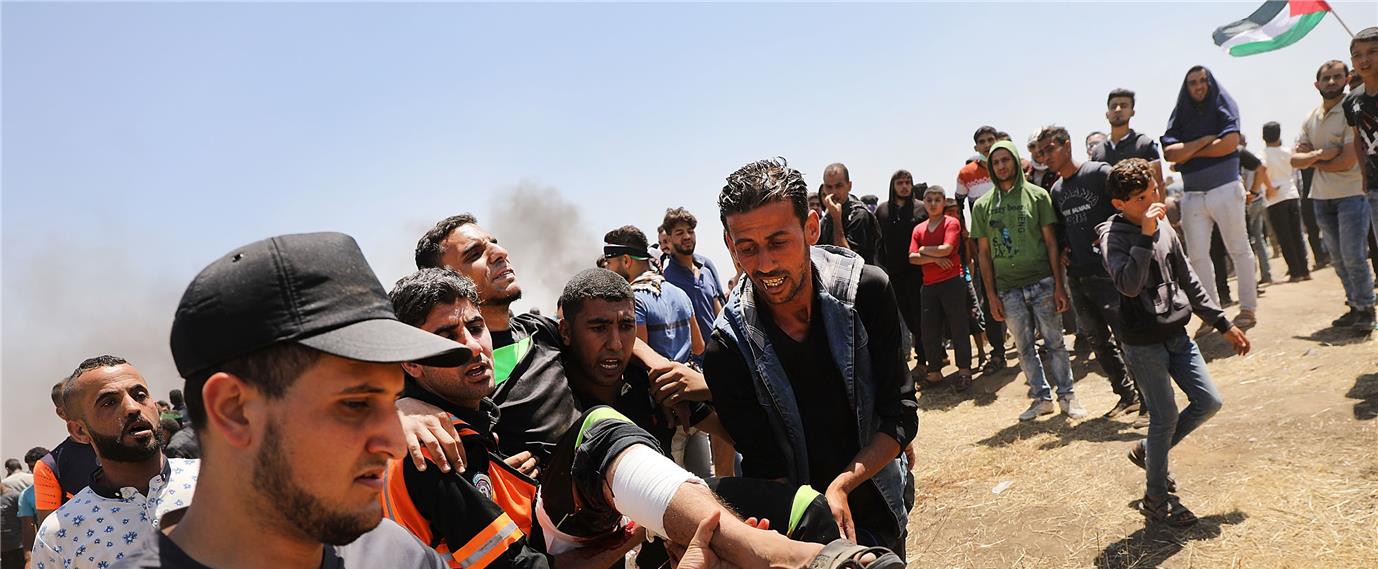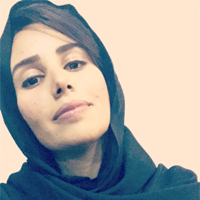"عين على الميدان وعين على الصحفيين الأجانب الموسومين بالسترة الواقية ذات اللون البني! يبدو أن وزنها أخف من المتوفر بغزة قبل سنوات الحصار.. كانت المرة الأولى التي أرى فيها درعًا بهذا اللون، يا ليتني منهم أو أعمل معهم!".. هذا ما يدور في ذهن الصحفية صافيناز اللوح بعدما لاحظت وجود سترات واقية من الرصاص يرتديها صحفيون أجانب وبعض من الزملاء في قطاع غزّة، خلال تغطيتهم أحداث مسيرة العودة الكبرى.
منذ بدء الحصار الإسرائيلي على قطاع غزّة، تمنع إسرائيل دخول السترات الواقية والخوذة والكمامات للصحفيين، ما يعني أن المتوفرة حاليا تعاني من هشاشة بسبب مرور وقت على انتهاء صلاحيتها واهترائها، خاصّة أن غزة تعتبر منطقة خصبة للأحداث الميدانية، إلا أن بعض الوكالات تستطيع توفيرها عبر طرق غير مباشرة، منها مثلا ترك الصحفيين الأجانب ستراتهم للصحفيين المحليين، أو بيعها لهم مقابل مبالغ متوسطة الثمن.
"كيف يميز الاحتلال الصحفيين؟ هل لبعض الصحفيين حماية دولية دونا عن غيرهم؟ ألا يُفترض أن نُعامل جميعا بنفس الطريقة؟ ماذا لو أُصبت أنا بالدرع الذي أرتديه، هل سيكون للأمر صدى كما لو أصيب أحدهم برصاصة؟ تتساءل الصحفية التي تعمل مصوّرة ومراسلة منذ العام 2011 لعدد من الوكالات المحلية، وحاليًا لصالح وكالة أمد الإعلامية منذ عامين.
جاكيت كحلي قيمته 250 شيكل، أي 67 دولارًا، محشو بقطع "إسفنجية"، ووزن لا يتجاوز الـ2 كيلو، يحيكه أحد الخياطين الذين لجأت الصحفية إليهم، لتوسم نفسها أمام رصاصة القناص المتربّص بالفلسطينيين على الحدود دون استثناء، آخذة بالحسبان مسافة الـ400 متر التي تفصل بينها وبين الجنود.
"جاكيت الصحافة" في شكله، يشبه الدرع الواقي، أحاكه الخياط بلون كحلي وطبع عليه كلمة "Press" بخطّ أبيض عريض، ترتديه صافيناز والعشرات من زملائها في محاولة للتحايل على الواقع المرير الذي يعيشه سكّان قطاع غزّة، بما فيهم الصحفيون حيث تمنع إسرائيل دخول الدروع منذ 12 عامًا.
تقول صافيناز إنها تغطي مسيرات العودة الكبرى منذ انطلاقها في الـ31 من آذار/مارس للعام 2018، في ثلاث مناطق حدودية وهي (شرق البريج، شرق غزة، وشرق جباليا)، من دون درع واق حقيقي ولا خوذة ولا كمامة، حتى بلغت عدد المرات التي أصيبت فيها خمس مرات ما بين استنشاق بالغاز، وكسر بالقدم إثر قنبلة غاز، والإصابة بقنبلة غاز أخرى بفروة الرأس، وشظية رصاصة بالكاحل الأيمن.
وتضيف "بالكاد كنت أستطيع توفير تكاليف علاجي في كل مرة أصاب فيها، فعليًا ما أتقاضاه يذهب للعلاج، فكيف سيكون بمقدوري شراء درع واق مستخدم مثلا، ويمكن أن يصل سعره إلى 400 دولار؟"
تتابع صافيناز أن الاحتلال الإسرائيلي اعتاد العمل على تكميم أفواه الصحفيين والصحفيات بممارساته المعروفة، والواضح في مسيرات العودة أن إسرائيل أخذت على عاتقها استهداف الصحفيين، والدليل عدد المصابين والمصابات من الزملاء، واستشهاد الزميلين أحمد أبو حسين وياسر مرتجى".
وتعتقد أن منع الدروع من دخول القطاع، بمثابة إجراء تتخذه إسرائيل كي يمتنع الصحفيون عن وسم أنفسهم بإشارة الصحافة باللغتين العربية والإنجليزية، وبالتالي استهدافهم مع وجود مبرر مسبق، وهو أنها لا تعلم أنهم صحفيون، لكن يبدو أن التحايل على الواقع قد سبّب إزعاجًا للاحتلال حتى صار يطلق النار على المناطق التي لا يحميها الدرع المهترئ أصلًا.
صحفيون في وكالات دولية
يقول محمد البابا الذي يعمل لصالح وكالة الأنباء الفرنسية "كنت أرتدي كافة معدات السلامة المهنية عندما أصبت برصاصة متفجّرة بقدمي اليمنى على مسافة تصل أكثر من 200 متر من المنطقة الحدودية"، وذلك خلال تغطيته أحداث مسيرة العودة الكبرى في الثامن من يونيو/حزيران للعام 2018، شرق جباليا شمال قطاع غزة.
إثر الإصابة، توقّف البابا الذي يعمل مصورًا منذ 20 عامًا مدّة 6 أشهر عن العمل، حيث سببت له كسورا في القدم والتهابات في العصب ما زال يعاني منها حتى اليوم، تحول دون العودة إلى العمل كلّما هم بذلك.
يفيد أن وكالته وفرت له جميع أدوات السلامة المهنية اللازمة بأحدث الإصدارات، كما يوجد قسم خاص يتابع وسائل الأمن والسلامة ويحدثها أولًا بأول وفقًا لمصلحة وأمن الصحفيين والصحفيات، إذ يحتوي الدرع الواقي مجموعة من الألياف الداخلية بالإضافة إلى وجود عظمات بلاستيكية عند منطقتي القلب والظهر لحمايتهما في حالات التعرض للرصاص، كما تحرف الألياف مسار الرصاصة فلا تخترق الدرع نحو الصدر مباشرة، فتحميه من الخطر، لكن ذلك لا يجدي إن وقع انفجار.
محمد دهمان، 30 عامًا يعمل مصورًا "فريلانسر" منذ العام 2009 للعديد من الوكالات الأجنبية، أبرزها وكالة الأنباء الصينية (شينخوا)، يقول إن عدم امتلاك الدرع الواقي والخوذة، خاصّة في أوقات الحروب يصعّب أمر مهمة التصوير نفسيا وحركيا.. نفسيا من ناحية عدم الاطمئنان لأنه في حالة الحروب يكون الدرع بوابة أمان من بعض الشظايا بأشكالها المختلفة سواء من الصواريخ أو من البنايات والحجارة، وحركيا يقيّده في تحديد أماكن التواجد وحصر التغطية والتنقل من مكان لمكان بحذر وقلق.
في مسيرات العودة، توفّر الوكالة الصينية لـمحمد أدوات السلامة المهنية التي تتمثل بالسترة الواقية من الرصاص والخوذة والكمامة، وهي غالبَا متوفرة لجميع العاملين بالميدان في الوكالة، معتبرًا أنها أحد إجراءات الحماية التي تميّز الصحفي عن سواه بين المتظاهرين، إذ يمكن أن تغضّ الرصاصة المصوّبة من الاحتلال عنه، وكي لا يعطي مبررًا للاحتلال أنه لم يكن يميّز نفسه، وبالتالي كان هدفًا مشروعًا.
لكنه يرى أيضًا أنه لا يعرف إذا كان الدرع يشكل في الحقيقة حماية فعلية للصحفيين والصحفيات، كونه يحتوي على ألواح حماية من الصدر والظهر بينما لا يحتوي عليها في الجانبين الأيسر والأيمن، وهذا ما حدث مع الصحفي الشهيد ياسر مرتجى الذي قتلته إسرائيل برصاصة اخترقت جسده من منطقة جانبية لا يغطيها الدرع، وكذلك المصوّر الجريح ياسر قديح الذي أصيب بنفس المنطقة، وكأنها رسالة واضحة من الاحتلال أننا نستطيع استهدافكم حتى وأنتم ترتدون الدروع الواقية وتميزون أنفسكم.
يؤكّد محمد أنه يحاول قدر الإمكان الالتزام بمسافة فاصلة بينه وبين الجنود لا تقل عن 300 متر، لتلاشي تعرّض حياته للخطر إلا أنه أصيب بقنبلة غاز في أحد أيام التغطية.
شركات الإنتاج تعاني
شركات الإنتاج الإعلامي في غزّة تعاني أيضًا؛ يقول فارس الغول من شركة الميادين الإعلامية إن قصّة إدخال السترات الواقية وأدوات السلامة المهنية عمومًا هي بمثابة أمر مستحيل، إلا من خلال الصحفيين الأجانب الذين يدخلون القطاع، ولا يستطيع الاحتلال منعهم من إدخالها معهم، أو من خلال طرق غير مباشرة.
ويضيف "ذرائع الاحتلال التي تقول إن الدروع يمكن أن تستخدمها المقاومة في أعمال لها، غير مبررة، فعدد الصحفيين في القطاع كبير جدًا، وفئة قليلة التي تمتلك الدروع والخوذ، حتى صار الصحفيون والصحفيات الفريلانسر يتحايلون على المنع بارتداء جاكيتات تدلل عليهم، كما يستخدمون خوذا تشبه التي يرتديها الشرطة وأفراد الدفاع المدني لحماية أنفسهم، كما فعل الشهيد أحمد أبو حسين، إلا أن الاحتلال أصابه وقتله رغم ذلك".
بحسب فارس فإن صلاحية الدروع غالبًا لا تتجاوز الخمس سنوات، ونوعياتها وألوانها مختلفة حسب الطلب والأسعار، حيث تتراوح ما بين 800 دولار و5000 دولار، بوزن يبدأ من 3 كيلو حتى الـ8 وفقًا لأنواعها وأسعارها، فمثلًا السترات المصنوعة من الألياف تحتاج إلى إبر لتجديد فعاليتها.
وفي شركة المنارة للإعلام، خلال العام 2011 كانت المرّة الأخيرة التي استطاعت الشركة استقطاب سترات واقية، معللة على لسان المنسّق باسل أبو حسان، أن إسرائيل تعمل على عرقلة وصول أي معدات سلامة مهنية للصحفيين دون أسباب مقنعة، إذ تكتفي الشركة بما هو موجود بغضّ النظر عن تاريخ صلاحيته، فلا خيار أمامها.
ويعتقد باسل أن الوكالات الدولية تستطيع إدخالها مع طواقمها الأجنبية من الذين يدخلون قطاع غزة بسهولة، إذ لا تستطيع إسرائيل عرقلة عملهم لأنهم يحملون جنسيات دول كبيرة مؤثرة، بخلاف الوكالات والمؤسسات المحلية التي يقيد الاحتلال عملهم ولا يجدون من يساندهم.
ومنذ ثمانية أشهر، فقد الوسط الإعلامي في قطاع غزّة الصحفيين ياسر مرتجى في السّادس من أبريل/ نيسان، وأحمد أبو حسين في الـ24 من الشهر نفسه، إثر إصابتهما برصاص القناص الإسرائيلي المتمركز على طول المناطق الحدودية شرق غزة، بينما كانا يمارسان عملهما بتغطية أحداث مسيرة العودة الكبرى.







































